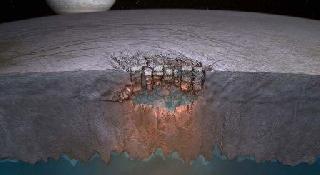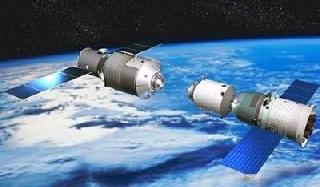
Europa's "Great Lake." Photo: Britney Schmidt/Dead Pixel VFX/Univ. of Texas at Austin.
PASADENA, CALIFORNIA (BNS): Data from a NASA planetary mission have provided scientists evidence of what appears to be a body of liquid water beneath the icy surface of Jupiter's moon, Europa.
The data suggest there is significant exchange between Europa's icy shell and the ocean beneath.
NASA's Galileo spacecraft, launched by the space shuttle Atlantis in 1989 studied Jupiter, which is the most massive planet in the solar system, and some of its many moons.
One of the most significant discoveries was the inference of a global saltwater ocean below the surface of Europa.
According to the data, this ocean is deep enough to cover the whole surface of Europa and contains more liquid water than all of Earth's oceans combined.
However, being far from the sun, the ocean surface is completely frozen. Most scientists think this ice crust is tens of miles thick.
Britney Schmidt, lead author of the paper published in journal Nature, and her team focused on Galileo images of two roughly circular, bumpy features on Europa's surface called chaos terrains.
Based on similar processes seen on Earth -- on ice shelves and under glaciers overlying volcanoes -- they developed a four-step model to explain how the features form.
The model resolves several conflicting observations. Some seemed to suggest the ice shell is thick. Others suggest it is thin.
This recent analysis shows the chaos features on Europa's surface may be formed by mechanisms that involve significant exchange between the icy shell and the underlying lake.
This provides a mechanism or model for transferring nutrients and energy between the surface and the vast global ocean already inferred to exist below the thick ice shell. This is thought to increase the potential for life there, it said.
Galileo was the first spacecraft to directly measure Jupiter's atmosphere with a probe and conduct long-term observations of the Jovian system. The probe was the first to fly by an asteroid and discover the moon of an asteroid.
NASA extended the mission three times to take advantage of Galileo's unique science capabilities, and the spacecraft was put on a collision course into Jupiter's atmosphere in September 2003 to eliminate any chance of impacting Europa.
 Previous Article
Previous Article Next Article
Next Article













The Indian Air Force, in its flight trials evaluation report submitted before the Defence Ministry l..
view articleAn insight into the Medium Multi-Role Combat Aircraft competition...
view articleSky enthusiasts can now spot the International Space Station (ISS) commanded by Indian-American astr..
view article